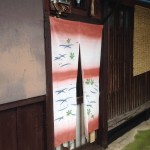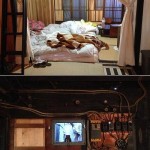Shrines, Gates, and Geishas in Kyoto
Kyoto is home to the largest concentration of UNESCO world heritage sites in Japan. This one city is a treasure trove of temples, shrines, and old palaces. You can walk in any direction and within 5 minutes you will bump into either a small Shinto shrine or a soccer-field sized Buddhist temple. Aside from the historical landmarks and visual smorgasbord on offer, I would have to say that our most memorable experience was where we spent the night – in an old, traditionally built Japanese house that I reserved on Airbnb.
Modernity collided peacefully with past twice that day. The first occurred when we took the Shinkansen train lightening speeds over to this majestic, classically Japanese city. The second was when we (finally) found this anachronism we were to call home for the next couple days.
After getting help from a couple of locals, we were able to locate the house we rented by entering the correct padlock code on the old wooden sliding door. (See pics below) When we got in, the first thing Jake (an electrician) noticed was how the electrical wiring was set up. The wires were exposed and running along the walls around the living spaces. It was almost like a race track the way the lines were run from the circuit breaker to the light fixtures and back. This is how the original electrical systems were installed most developed countries.
This house taught us more than a vocational lesson – we got to experience first hand how a typical Japanese might have lived since the 1950s. Aside from the heated toilet seat, not much else was modernized. The tatami floors in the living room and bedroom were a good-enough replacement for chairs and beds. We rolled out our beds at night and rolled them back up in the morning. The walls of the interior rooms were mostly paper and wood. The bedroom wall to the outside was also a kind of sliding door, making the nights a little chillier than we expected. And all sounds from the neighbors’ homes could be heard through the walls without any effort. Finally, the skylights provided enough light to serve as a natural alarm clock in the morning.
There was no escaping this community wrapped around us. For better or worse, we would be inextricably part to the environment we were living in – no TV, no internet, and no privacy. It was in Kyoto that I understood what it means to live peacefully in a community. There was no shutting out your neighbors or the natural world.









